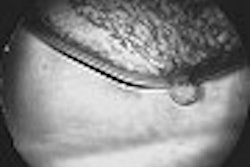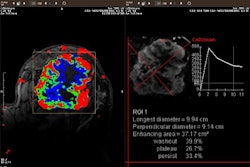Community-based mammography screening programs in North America produce a higher percentage of false-positive readings than similar programs in other countries, researchers report in the September 17 issue of the Journal of the National Cancer Institute. Concerns about litigation could be a contributing cause, according to the authors.
"Variability in screening mammography interpretations may have important clinical and economic implications," wrote lead researcher Dr. Joann Elmore, associate professor of medicine and adjunct associate professor of epidemiology at the University of Washington School of Medicine in Seattle. "Although clinicians do not wish to miss breast cancers, it is important to minimize unnecessary follow-up diagnostic procedures, costs, and patient anxiety associated with false-positive screening mammograms."
Using data from 32 studies of community-based screening mammography programs in North America and other countries, Elmore and her co-investigators, including Dr. Carl D’Orsi, director of breast imaging at Emory University School of Medicine in Atlanta, analyzed the percentage of mammograms considered abnormal; the percentage of women diagnosed with ductal carcinoma in situ (DCIS); and the percentage diagnosed with minimal disease (JNCI, September 17, 2003, Vol. 95:18, pp. 1,384-1,393).
According to the results, the percentage of mammograms deemed abnormal by North American programs was 2 to 4 percentage points higher than similar programs in other countries. A statistical analysis of the data adjusted for factors such as age and number of mammography readers for each examination (single versus double).
North American programs also reported a higher percentage of DCIS. However, the higher percentage of abnormal mammograms was not associated with a higher rate of diagnosis for breast cancer.
The authors noted that factors involved in the observed variations include differences in the population of women screened, differences in the screening procedure, and differences in how countries define an abnormal mammogram. They also said that malpractice and financial concerns are an issue.
"I suspect that medical malpractice concerns are contributing to the high recall rates noted in North American screening programs," Elmore said. "Radiologists in the U.S. might be reluctant to label a mammogram as 'normal,’ thus leading to higher recall rates. Malpractice concerns have been shown to affect physicians' ordering of tests and procedures."
"Failure or delay in cancer diagnosis is the most frequent allegation in medical malpractice claims in the U.S., with issues related to breast cancer, particularly delay in diagnosis, being the most common cause of malpractice claims for all specialties." she added.
Commenting on the issue, Dr. Leonard Berlin pointed out that "intervention is the capstone of American medicine. People expect doctors to do something.… In other words, radiologists who see something even remotely suspicious on a mammogram will probably over-read the study, suggesting not only a recall but frequently a biopsy as well." Berlin is chairman of the department of radiology at Rush North Shore Medical Center in Skokie, IL. He frequently writes on legal issues in imaging for the American Journal of Roentgenology.
Berlin added that radiologists are not likely to be sued for ordering a biopsy, but rather for "not suggesting biopsy, and instead recommending follow-up in 3, or 6, months, if that remote questionable abnormality does indeed turn out to be cancer. This is an unfortunate fact of medical life in the malpractice environment in the U.S. today."
The fact that North American radiologists feel the need to err on the side of caution emphasizes the urgency for better breast screening methods, said Dr. Cheryl Perkins, senior clinical advisor of the Dallas-based Susan G. Komen Breast Cancer Foundation.
"The fact that this study reports North America as having a higher percentage of false-positive mammograms highlights the need for further study to identify the factors that contributed to this variability," she said. "The hope is that, through research, there will be improvements in the current technology, as well as the development of newer and better screening methods that will offer women more specific and uniform results. However, until more consistently reliable screening technology is available, mammography remains the gold standard for breast cancer screening."
By Bruce SylvesterAuntMinnie.com contributing writer
September 16, 2003
Related Reading
Making mammographers better: The last link in the imaging chain, August 29, 2003
Radiology residents not interested in reading mammograms, June 9, 2003
Driving improvement without driving the docs away: rethinking the MQSA, May 27, 2003
Radiologists say training, not tests, will hone mammography skills, April 10, 2003
Lawmakers mull mandatory testing of radiologists' skills in reading mammograms, April 8, 2003
Recently trained radiologists may interpret mammograms more accurately, February 27, 2003
Copyright © 2003 AuntMinnie.com



















